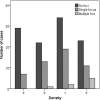Foci on breast magnetic resonance imaging in high-risk women: cancer or not?
- PMID: 27169908
- PMCID: PMC4942496
- DOI: 10.1007/s11547-016-0644-3
Foci on breast magnetic resonance imaging in high-risk women: cancer or not?
Abstract
Purpose: To assess how frequently foci are identified on MRI in high-risk patients, and their association with malignancy, breast density, and background parenchymal enhancement (BPE).
Materials and methods: In this multicentric study, two readers, in consensus, retrospectively reviewed screening breast MRI of 245 high-risk women, performed between 2009 and 2014. Eligible patients had at least two consecutive screening MRI, and a follow-up of at least 1 year after a lesion was first detected; histology was available for all suspicious findings. Breast density, BPE (both using BI-RADS lexicon), presence, and changes at follow-up for foci were evaluated. Clinical history of the patients was reviewed. Chi-square test was used to define significant correlations.
Results: 166 women (mean age 43 years), who underwent a median of 4 MRI (range 2-6) during the study period, were included. 68 foci were found in 58 women [34.9 %, 95 % confidence interval (CI) 28.1-42.5 %]. Foci were more frequent in dense breasts (P = 0.079) and with moderate or marked BPE (P < 0.001). During follow-up, two foci increased in size (2.9 %, 95 % CI 0.8-10.1 %) and at biopsy, a cancer was found (1 high-grade ductal carcinoma in situ, 1 tubular carcinoma). Breast cancer was diagnosed in the other three cases, not initially appearing as foci, and it was more frequent in women with dense breasts (P = 0.04); no correlation between cancer and BPE was found (P = 0.145).
Conclusions: Foci are relatively frequent in screening MRI, and they are usually benign. An increase in size is the most reliable criteria to suspect malignancy.
Keywords: BI-RADS; Breast; Cancer; High-risk; Magnetic resonance imaging.
Figures




Similar articles
-
Characteristics, Malignancy Rate, and Follow-up of BI-RADS Category 3 Lesions Identified at Breast MR Imaging: Implications for MR Image Interpretation and Management.Radiology. 2016 Sep;280(3):707-15. doi: 10.1148/radiol.2016151548. Epub 2016 Apr 18. Radiology. 2016. PMID: 27089027
-
Breast Background Parenchymal Enhancement on Screening Magnetic Resonance Imaging in Women Who Received Chest Radiotherapy for Childhood Hodgkin's Lymphoma.Acad Radiol. 2016 Feb;23(2):168-75. doi: 10.1016/j.acra.2015.09.010. Epub 2015 Nov 3. Acad Radiol. 2016. PMID: 26546383
-
Effect of Background Parenchymal Enhancement on Cancer Risk Across Different High-Risk Patient Populations Undergoing Screening Breast MRI.AJR Am J Roentgenol. 2019 Mar 19;212(6):1412-1418. doi: 10.2214/AJR.18.20566. AJR Am J Roentgenol. 2019. PMID: 30888867
-
The Association of Background Parenchymal Enhancement at Breast MRI with Breast Cancer: A Systematic Review and Meta-Analysis.Radiology. 2019 Sep;292(3):552-561. doi: 10.1148/radiol.2019182441. Epub 2019 Jun 25. Radiology. 2019. PMID: 31237494
-
Background parenchymal enhancement in breast magnetic resonance imaging: A review of current evidences and future trends.Diagn Interv Imaging. 2018 Dec;99(12):815-826. doi: 10.1016/j.diii.2018.08.011. Epub 2018 Sep 22. Diagn Interv Imaging. 2018. PMID: 30249463 Review.
Cited by
-
Lesion characteristics, histopathologic results, and follow-up of breast lesions after MRI-guided biopsy.Diagn Interv Radiol. 2017 Sep-Oct;23(5):333-338. doi: 10.5152/dir.2017.17004. Diagn Interv Radiol. 2017. PMID: 28830847 Free PMC article.
-
'Earlier than Early' Detection of Breast Cancer in Israeli BRCA Mutation Carriers Applying AI-Based Analysis to Consecutive MRI Scans.Cancers (Basel). 2023 Jun 8;15(12):3120. doi: 10.3390/cancers15123120. Cancers (Basel). 2023. PMID: 37370730 Free PMC article.
-
A machine learning approach for differentiating malignant from benign enhancing foci on breast MRI.Eur Radiol Exp. 2020 Jan 28;4(1):5. doi: 10.1186/s41747-019-0131-4. Eur Radiol Exp. 2020. PMID: 31993839 Free PMC article.
References
-
- Lord SJ, Lei W, Craft P, et al. A systematic review of the effectiveness of magnetic resonance imaging (MRI) as an addition to mammography and ultrasound in screening young women at high risk of breast cancer. Eur J Cancer (Oxf Engl 1990) 2007;43:1905–1917. doi: 10.1016/j.ejca.2007.06.007. - DOI - PubMed
Publication types
MeSH terms
Substances
LinkOut - more resources
Full Text Sources
Other Literature Sources
Medical

